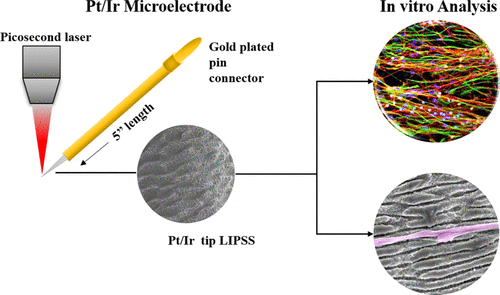当前位置:
X-MOL 学术
›
ACS Biomater. Sci. Eng.
›
论文详情
Our official English website, www.x-mol.net, welcomes your
feedback! (Note: you will need to create a separate account there.)
Laser-Induced Periodic Surface Structure Enhances Neuroelectrode Charge Transfer Capabilities and Modulates Astrocyte Function
ACS Biomaterials Science & Engineering ( IF 5.4 ) Pub Date : 2020-02-12 , DOI: 10.1021/acsbiomaterials.9b01321 Adriona Kelly 1 , Nazar Farid 2 , Katarzyna Krukiewicz 1, 3 , Nicole Belisle 1 , John Groarke 1 , Elaine M. Waters 4 , Alexandre Trotier 1 , Fathima Laffir 5 , Michelle Kilcoyne 4 , Gerard M. O’Connor 1, 2 , Manus J. Biggs 1
ACS Biomaterials Science & Engineering ( IF 5.4 ) Pub Date : 2020-02-12 , DOI: 10.1021/acsbiomaterials.9b01321 Adriona Kelly 1 , Nazar Farid 2 , Katarzyna Krukiewicz 1, 3 , Nicole Belisle 1 , John Groarke 1 , Elaine M. Waters 4 , Alexandre Trotier 1 , Fathima Laffir 5 , Michelle Kilcoyne 4 , Gerard M. O’Connor 1, 2 , Manus J. Biggs 1
Affiliation

|
The brain machine interface (BMI) describes a group of technologies capable of communicating with excitable nervous tissue within the central nervous system (CNS). BMIs have seen major advances in recent years, but these advances have been impeded because of a temporal deterioration in the signal to noise ratio of recording electrodes following insertion into the CNS. This deterioration has been attributed to an intrinsic host tissue response, namely, reactive gliosis, which involves a complex series of immune mediators, resulting in implant encapsulation via the synthesis of pro-inflammatory signaling molecules and the recruitment of glial cells. There is a clinical need to reduce tissue encapsulation in situ and improve long-term neuroelectrode functionality. Physical modification of the electrode surface at the nanoscale could satisfy these requirements by integrating electrochemical and topographical signals to modulate neural cell behavior. In this study, commercially available platinum iridium (Pt/Ir) microelectrode probes were nanotopographically functionalized using femto/picosecond laser processing to generate laser-induced periodic surface structures (LIPSS). Three different topographies and their physical properties were assessed by scanning electron microscopy and atomic force microscopy. The electrochemical properties of these interfaces were investigated using electrochemical impedance spectroscopy and cyclic voltammetry. The in vitro response of mixed cortical cultures (embryonic rat E14/E17) was subsequently assessed by confocal microscopy, ELISA, and multiplex protein array analysis. Overall LIPSS features improved the electrochemical properties of the electrodes, promoted cell alignment, and modulated the expression of multiple ion channels involved in key neuronal functions.
中文翻译:

激光诱导的周期性表面结构增强神经电极电荷转移能力并调节星形胶质细胞功能
脑机接口(BMI)描述了一组能够与中枢神经系统(CNS)中的兴奋性神经组织进行通信的技术。近年来,BMI已经取得了重大进步,但是由于插入CNS后记录电极的信噪比随时间而变差,因此阻碍了这些进步。该恶化归因于固有的宿主组织反应,即反应性神经胶质增生,其涉及一系列复杂的免疫介体,通过促炎性信号分子的合成和神经胶质细胞的募集导致植入物封装。临床上需要减少原位组织包裹并改善长期神经电极功能。通过整合电化学和形貌信号来调节神经细胞行为,纳米级电极表面的物理修饰可以满足这些要求。在这项研究中,使用飞秒/皮秒激光加工技术对市售的铂铱(Pt / Ir)微电极探针进行了纳米形貌功能化,以生成激光诱导的周期性表面结构(LIPSS)。通过扫描电子显微镜和原子力显微镜评估了三种不同的形貌及其物理性质。使用电化学阻抗谱和循环伏安法研究了这些界面的电化学性质。随后通过共聚焦显微镜,ELISA和多重蛋白阵列分析评估混合皮质培养物(胚胎大鼠E14 / E17)的体外反应。
更新日期:2020-02-12
中文翻译:

激光诱导的周期性表面结构增强神经电极电荷转移能力并调节星形胶质细胞功能
脑机接口(BMI)描述了一组能够与中枢神经系统(CNS)中的兴奋性神经组织进行通信的技术。近年来,BMI已经取得了重大进步,但是由于插入CNS后记录电极的信噪比随时间而变差,因此阻碍了这些进步。该恶化归因于固有的宿主组织反应,即反应性神经胶质增生,其涉及一系列复杂的免疫介体,通过促炎性信号分子的合成和神经胶质细胞的募集导致植入物封装。临床上需要减少原位组织包裹并改善长期神经电极功能。通过整合电化学和形貌信号来调节神经细胞行为,纳米级电极表面的物理修饰可以满足这些要求。在这项研究中,使用飞秒/皮秒激光加工技术对市售的铂铱(Pt / Ir)微电极探针进行了纳米形貌功能化,以生成激光诱导的周期性表面结构(LIPSS)。通过扫描电子显微镜和原子力显微镜评估了三种不同的形貌及其物理性质。使用电化学阻抗谱和循环伏安法研究了这些界面的电化学性质。随后通过共聚焦显微镜,ELISA和多重蛋白阵列分析评估混合皮质培养物(胚胎大鼠E14 / E17)的体外反应。











































 京公网安备 11010802027423号
京公网安备 11010802027423号